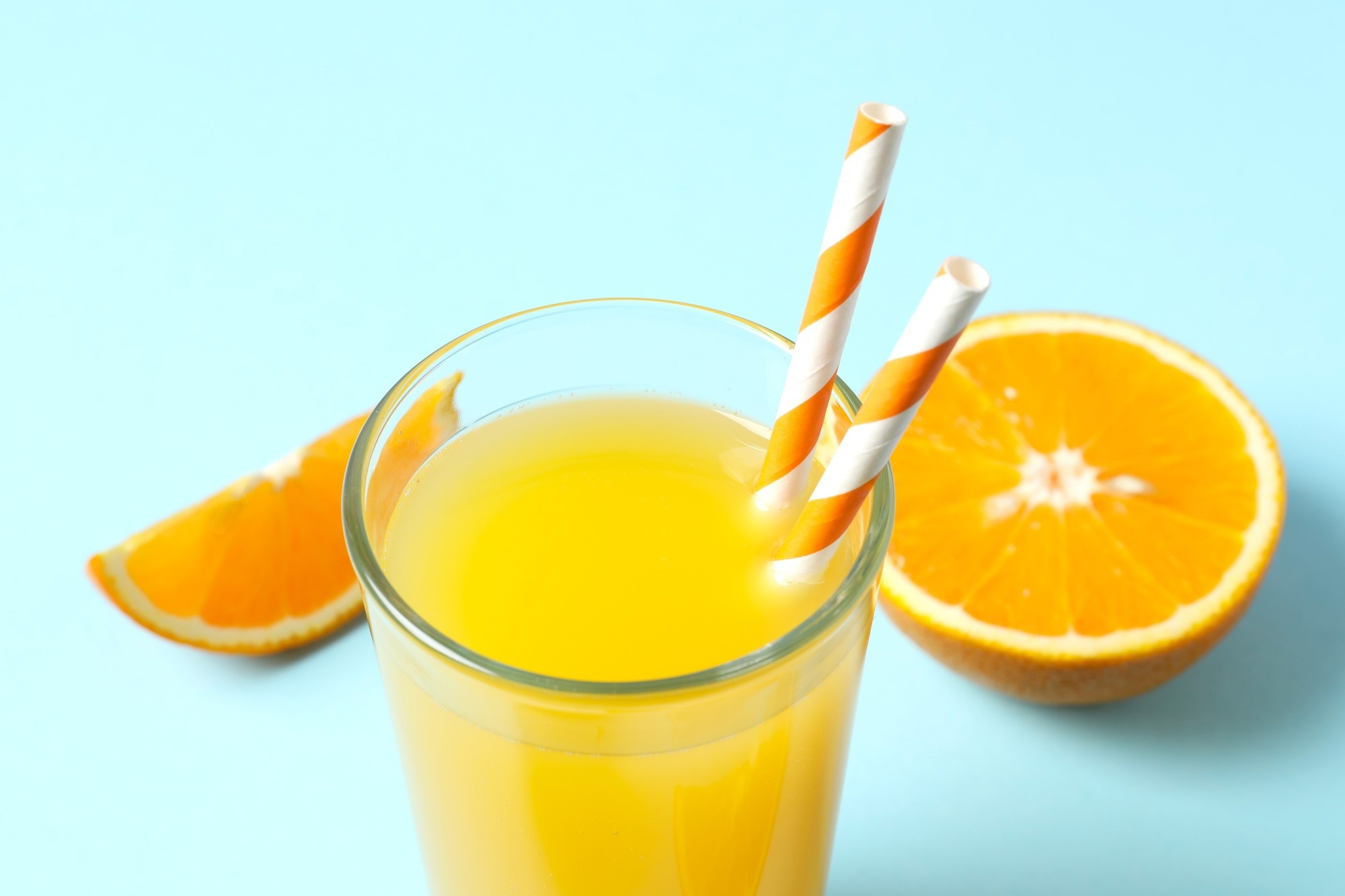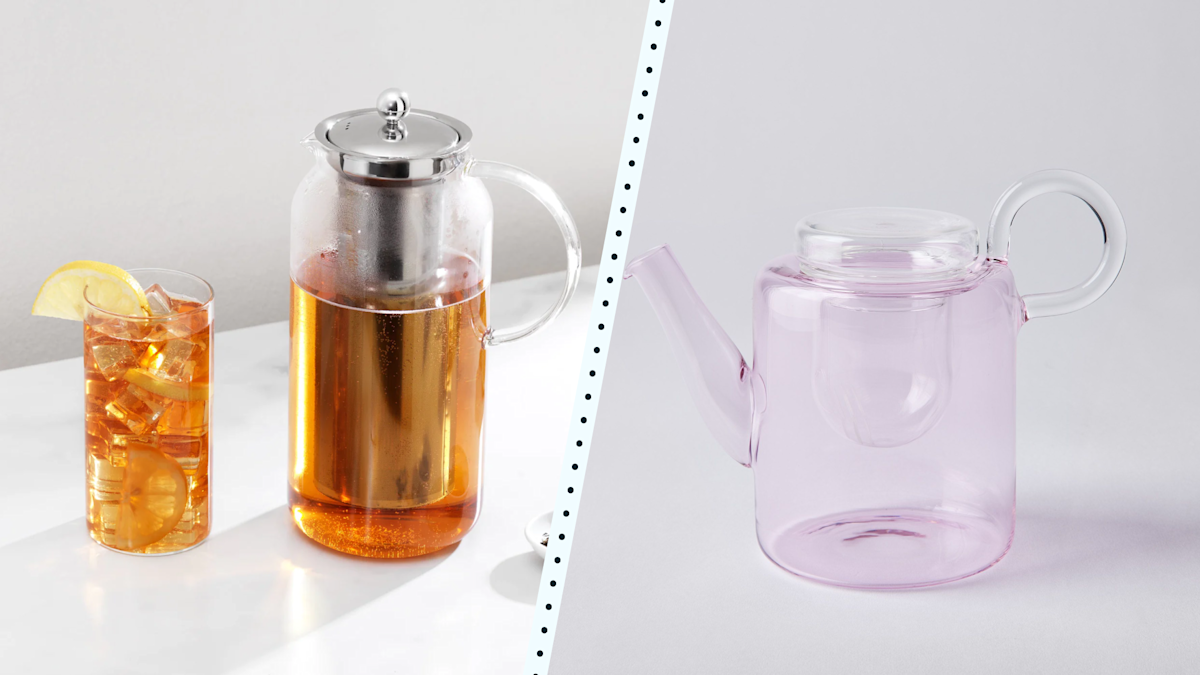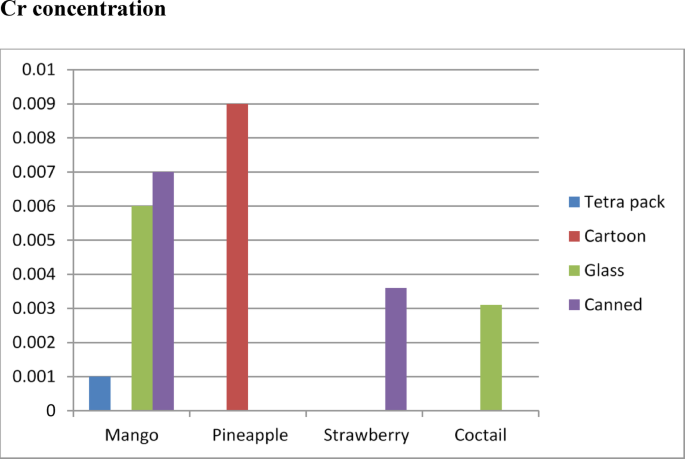
Concentration of the toxic metals in fruit juice sample
The present study was conducted to assess the concentration of toxic metals and health risks in commercially available packed fruit juice products. 80 samples categorized in four groups were studied; among those 50 of them were in group 1 mango juice (B1-waw mango juice, B4- 7Star, B7- Dada mango, B3-3D mango, and B8-7star plastic) with different packaging materials; 10 were pineapple (cartoon), strawberry (canned), and mixed cocktail (glass), respectively. Processed fruit juice may contain toxic metals depending on many factors, such as soil used for cultivation, irrigation of water, chemical additives, preservatives, and packaging materials. In this study, the wet digestion system was preferred because of its higher accuracy with respect to both time and recovery values. The recovery values were nearly quantitative for the wet digestion method.
The median concentrations of toxic metals were determined in 80 samples, with 0.08 ± 0.026 being the median and interquartile range value of cadmium with 0.010 and 0.1 maximum and minimum values, whereas 0.004 ± 0.002 was the chromium median and interquartile values. The median concentration of the toxic metals in 80 fruit juice samples in un-spiked and spiked samples was summarized in Table 5. The detailed concentrations of the four toxic metals in the analyzed fruit juice samples are presented in Supplementary Table S1, while the comparison of these concentrations with values reported in other countries is provided in Supplementary Table S2.
Cadmium (Cd)
Cadmium concentrations in this study ranged from 0.01 to 0.1 mg/L, with a median value of 0.08 mg/L that exceed the WHO recommended limit of 0.003 mg/L25. Compared to other studies, cadmium levels in this study were lower than those reported in Iraq (0.01–2.40 mg/L)26 and Nigeria (0.01-5.68 mg/L)2. But higher than levels observed in Brazil (0.035–0.062 mg/L) and Romania (0.012–0.142 mg/L)27. The highest concentration in this study was found in canned strawberry juice, while the lowest was in mango and cocktail juices in glass containers, as shown in Fig. 1. These findings are lower than cadmium levels reported in strawberry juice from Rwandan markets (0.77 mg/L)28. Study on Poland demonstrated that the content of Cd in mango juice were 0.157 mg/L which is higher than in the current study29. Cadmium is a non-essential and toxic heavy metal found in food and water, known to accumulate in the kidneys and liver. In addition to being a naturally occurring element in soil, cadmium is also widely distributed in the environment due to human activity. Its poisoning can result in cancer as well as problems with the kidneys, liver, skeletal system, bone demineralization, and respiratory problems30. Variations across studies may result from differences in analytical methods, solvents, digestion procedures, and instrumentation. Cadmium and its compounds were classified as carcinogenic to humans by the International Agency for Research on Cancer (IARC) in 1993. According to FAO/WHO guidelines, cadmium exposure should be minimized to protect public health31.

Distribution of cadmium concentration in fruit juice samples in Gondar City, North West, Ethiopia, 2022 (n = 80).
Chromium (Cr)
The concentration of chromium in this study ranged from 0.0003 to 0.0081 mg/L, with a median value of 0.004 mg/ that was below WHO guideline of 0.05 mg/L32. A study from Nigerian metropolis (0.172 ± 0.05 mg/L)33 and Pakistan reported concentration of chromium 0.039 mg/L which is higher than the present study34. Figure 2 shows the highest concentrations of chromium were found in pineapple juice (cartoon) and mango juice (tetra pack), and the lowest concentrations were in strawberry and in a cocktail (glass). A study conducted in Saudi Arabia reported a chromium concentration of 0.0078 mg/L in mango juice brands, which is higher than the levels found in the current study35. Cr concentration ranged between 0.018 mg/L in the juice samples collected from a market in Spain36. The variation in concentration may be from Digestion procedure, instrument used, packaging material and method of production.Ingestion in food and beverages represent the principle route of chromium intake. Low levels of chromium cause DNA-bound with chromium (III) ions that may contribute to chromium mutagenesis and carcinogenesis by altering the kinetics and fidelity of DNA replication. Also, excess exposure to chromate compounds has long been associated with diseases of the respiratory system. Excess amounts may cause allergy, produce pulmonary sensitization and bronchogenic carcinomas37. IARC has classified chromium (VI) compounds as “carcinogenic to humans” (Group 1) by the inhalation route of exposure38.
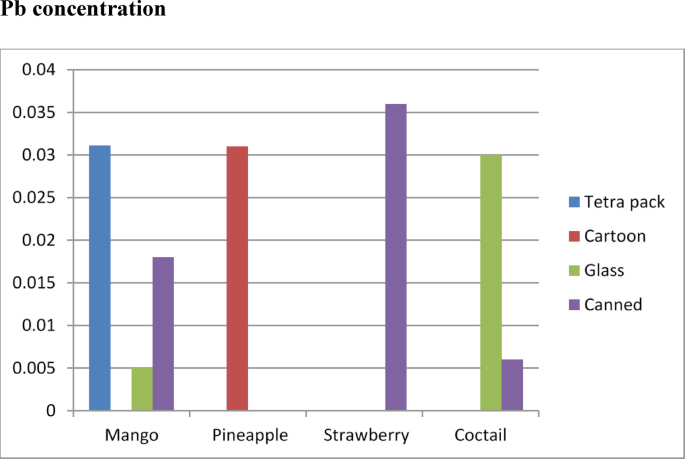
Distribution of cadmium concentration in fruit juice samples in Gondar City, North West, Ethiopia, 2022 (n = 80).
Lead (Pb)
In this study, lead concentrations range from 0.01 to 0.04 mg/L and a median value of 0.035 mg/L in all fruit juice samples, which is higher than the maximum standard limit set by the WHO that is 0.02 mg/L39. A study in Poland done on of fruit juice present a level of lead(Pb) of approximately 0.01 mg/L which is lower than the current study40. In Iran and Ghana, the range of concentration for Pb in fruit juices was 0.028–0.07 mg/L and 0.90–1.59 mg/L, respectively, which were higher than the current study41. Study from Iran reported the level of Pb as 0.028 to 0.067 mg/L which is relatively similar to the current study. The concentration of Lead in strawberry (canned) and mixed cocktail (glass) were found to be higher while the lowest concentration noted in mango (glass) and pineapple (cartoon) fruit juice samples respectively in present study as indicated in Fig. 3. Similar study in Iran were found the concentration for Pb in fruit canned juice 0.91 mg/L which was higher than the present study found for canned fruit juice samples28.
A study in Saudi Arabia demonstrated that the level of Pb in mango juice samples were 0.027 mg/L which is less than in the present stud42. In products from Egypt, found the concentration of lead (Pb) in pineapple nectar juice at0.012 mg/L which is lower than this study29.The causes of the concentration difference could be the irrigation water, the digestive process, or the preservatives utilized. Lead can enter the food supply through various pathways, including contaminated water, water supply and food processing method.Even at relatively low levels, lead causes serious health impacts. It can harm the developing neural systems and cause death by crossing the placenta. Pb damages the kidneys, liver, heart, vascular and immunological systems, and can result in both acute and chronic poisoning43.
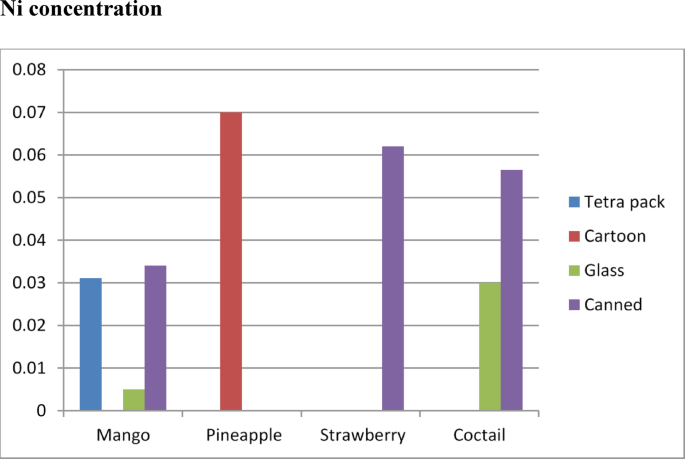
Distribution of lead concentration in fruit juice samples in Gondar City, North West, Ethiopia, 2022 (n = 80).
Nickel
In this investigation, the concentration of nickel ranged from 0.0025 to 0.08 mg/L with a median value of 0.078 mg/L which is higher than the maximum level of nickel set by WHO, 0.02 mg/L44. A study from Saudi Arabia demonstrated the range of Ni in different packaged fruit juice varies from 0.0091 to 0.0573 mg/L which is lower than the current study42. In this study the highest concentrations of Ni were recorded in pineapple cartoon juice, strawberry canned, and cocktail, while mango (glass) juice had the lowest level of Ni as shown in Fig. 4. A study in Pakistan demonstrated the higher level of Ni (12 mg/L) in canned fruit juice, which is very high from the current study45. The observed variation of toxic metal concentration in different processed fruit juice samples might be due to fruit juice processing method, natural content of metals in the fruit, meteorological circumstances, and procedure of analysis conditions, analytical solvents used, digestion technique, and instrumentation. Nickel can enter the food supply through various sources including soil and water contamination, fertilizers and pesticides and food processing equipment. It plays an important role in biological systems such as enzyme activities in hormonal control, in RNA, DNA, and protein structural function. Symptoms of Ni toxicity include dizziness, short and rapid respiration, and cyanosis46.
Ni concentration
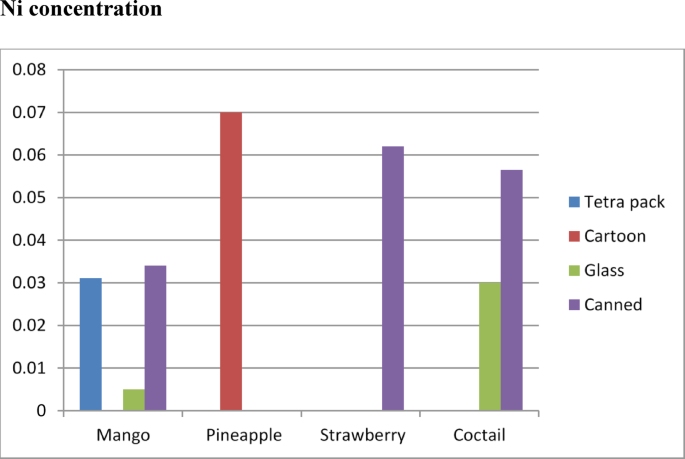
Distribution of lead concentration in fruit juice samples in Gondar City, North West, Ethiopia, 2022 (n = 80).
Kruskal-Wallis test
A Kruskal-Wallis test was conducted to examine the median differences of cadmium, chromium, lead, and nickel content in the packed fruit juice samples according to the type of ingredient of fruit juice in 80 fruit juice samples. Table 6 shows that the values of nickel (p-value = 0.001) and chromium (p-value = 0.018) were found to be statistically significant in the four groups of fruit juice samples. And a significant statistical difference was shown in chromium and nickel among eighty fruit juice samples and between the groups of the juice based on their ingredients. This might be because the fruit juice processing method and the natural content of metals in the fruit species may affect the concentration of chromium and nickel47.
Toxic metals, such as cadmium, chromium, lead, and nickel, are found in fruit juice processing and packaging materials due to environmental exposure, pollution, and the combustion of fuel in refinery processes, industrial emissions, and packaging materials like colorants and stabilizers in plastic. It is also known to be highly contaminated by phosphate-based fertilizer that is used in the plantation. Toxic metals are of great interest in the analysis of fruit juice because of its toxicity, which has implications for health48.
Health risk assessment
Based on the above equation THQ, HI and CR for children are summarized in the Table 7.
Health risk assessment associated with toxic metal contamination in processed fruits products for children was calculated by estimating the target hazard quotient (THQ), hazard index (HI), and cancer risk (CR) for individual metals based on estimated daily intake (CDI). It is one of the vital health risk assessment tools. It takes into account the frequency and duration of exposure and the bodyweight of the exposed persons. In general, health risk due to metal contamination depends on the average daily dietary intake and metal concentration in the food49.
The non-carcinogenic risk was estimated by THQ for toxic metals and ranked as Cd > Pb > Ni > Cr and the hazard index for all metals, HI = 0.171, which is lower than 1, implies adverse health effects will not occur. Carcinogenic risk of toxic metals was estimated by CR and ranked as Ni > Cd > Cr > Pb. All metals levels were below the USEPA threshold range. THQ for all metals in fruit juice samples is less than 1, which indicates that there will not be a non-carcinogen health risk for children. A study from Pakistan on quantification of metals presented the target hazard quotient (THQ) and hazard index (HI) of Pb, which were relatively high to the current study. But cancer risk (TCR) assessment indicates that these metals were within the acceptable limit. Another study in Iran from the Teheran market found that THQ for Pb in children was less than 150.
Limitation of the study
The limitation of the present study was that the toxic metal analysis only included 8 brands of fruit juice samples to estimate potential health risks, which is not enough to generalize about the health risks of packed fruit juice for children. Because of the unavailability of materials for toxic metal analysis, others were not quantified.
Conclusion and future directions
This study assessed the concentrations of selected toxic metals Cd, Cr, Pb and Ni, and their health risks in packaged fruit juices. The concentration of Cr remained below the permissible limits set by WHO, while the concentrations of Cd, Pb, and Ni exceeded these limits in several samples, particularly in strawberry juice (canned) and pineapple juice (carton). The health risk assessment, using Target Hazard Quotient (THQ) and Carcinogenic Risk (CR) were below the standard limits of USEPA. Packaging type significantly influenced metal concentrations, with juices stored in cans, cartons, and glass containers showing higher levels of Cd, Pb, and Ni compared to those stored in tetra packs and plastic. Therefore, regular consumption of such products, particularly by children, may pose adverse health effects due to cumulative metal exposure. Based on the findings, several recommendations are proposed to enhance food safety and minimize toxic metal contamination in fruit juice production. Regulatory authorities should enforce stricter control measures, such as the implementation of Hazard Analysis and Critical Control Points (HACCP) systems, to effectively monitor and reduce contamination risks. Packaging materials that may leach toxic metals such as cans, certain cartons, and glass with metallic components should be restricted or subjected to rigorous quality assessments to ensure safety. Tetra pack packaging is identified as a safer alternative and is particularly recommended for products intended for children due to its lower risk of metal leaching. Furthermore, additional research is necessary to validate these findings, identify specific sources of contamination, and clarify the mechanisms through which toxic metals enter fruit juice during processing and packaging.
link



